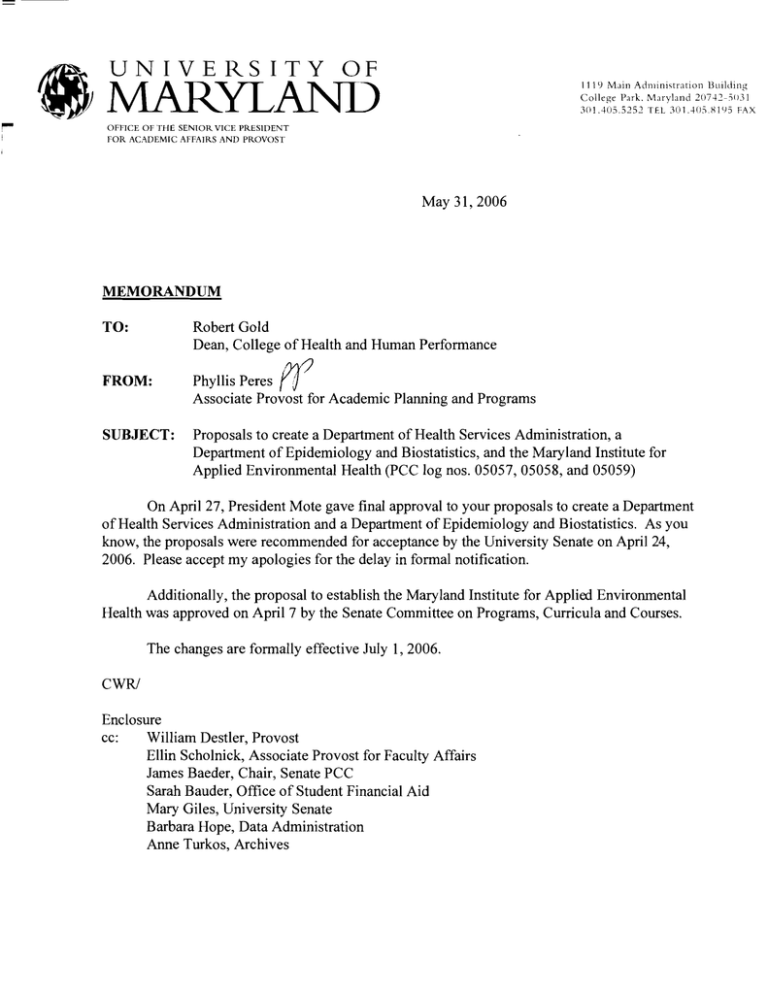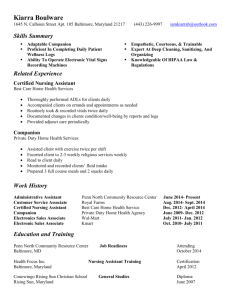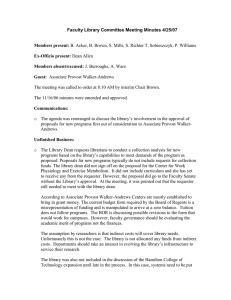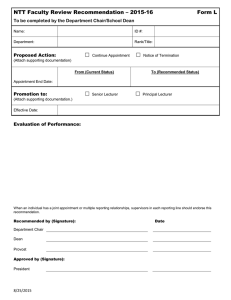l \ l r A P m O F
advertisement

UNIVERSITY OF l\lrAPm I 1 19 Main Administration U u i l d i n ~ College Park. Maryland 20741-5031 301.405.5252 T E L 3Cl1.40.5.81'J5 FAX OFFICE O F THE SENIORVICE PRESIDENT FOR ACADEMIC AFFAIRS AND PROVOST May 3 1,2006 MEMORANDUM TO: Robert Gold Dean, College of Health and Human Performance FROM: Phyllis Peres Associate Provost for Academic Planning and Programs SUBJECT: Proposals to create a Department of Health Services Administration, a Department of Epidemiology and Biostatistics, and the Maryland Institute for Applied Environmental Health (PCC log nos. 05057, 05058, and 05059) On April 27, President Mote gave final approval to your proposals to create a Department of Health Services Administration and a Department of Epidemiology and Biostatistics. As you know, the proposals were recommended for acceptance by the University Senate on April 24, 2006. Please accept my apologies for the delay in formal notification. Additionally, the proposal to establish the Maryland Institute for Applied Environmental Health was approved on April 7 by the Senate Committee on Programs, Curricula and Courses. The changes are formally effective July 1, 2006. Enclosure cc: William Destler, Provost Ellin Scholnick, Associate Provost for Faculty Affairs James Baeder, Chair, Senate PCC Sarah Bauder, Office of Student Financial Aid Mary Giles, University Senate Barbara Hope, Data Administration Anne Turkos, Archives THE UNIVERSITY OF MARYLAND, COLLEGE PARK PROGRAM/CURRICULUM PROPOSAL DIRECTIONS: Provide one form with original approval signatures in lines 1 - 4 for each proposed action. Keep this form to one page in length. Early consultation with the Office of the Associate Provost for Academic Planning & Programs is strongly recommended if there are questions or concerns, particularly with new programs. Please submit the signed form to Claudia Rector, Office of the Associate Provost for Academic Planning and Programs, 1119 Main Administration Building, Campus. Please email the rest of the proposal as an MSWord attachment to pcc-submissions@umd.edu. PCC LOG NO. DATE SUBMITTED March 17,2006 COLLEGEISCHOOL College of Health and Human Performance 05059 DEPARTMENTIPROGRAM proposed Maryland Institute for Applied Environmental Health PROPOSED ACTION ( A separate form for each) ADD X DELETE CHANGE DESCRIPTION (Provide a succinct account of the proposed action. Details should be provided in an attachment. Provide old and new sample programs for curriculum changes.) Please see attached document. JUSTIFICATION/REASONS/RESOURCES(Briefly explain the reasonfor the proposed action. Identify the source of new resources that may be required. Details should be provided in an attachment.) Please see attached document. ............................................................................... ............................................................................... APPROVAL SIGNATURES DATE 1. Department Committee Chair 2. Department Chair .3 - / k - 0 6 3. College/School PCC Chair 4. Dean / 3-/ 7-06 5. Dean of the Graduate School (if required) 4-3-06 6. Chair, Senate PCC 7. Chair of Senate V 8. Vice President for Academic Affairs & Provost 5~3-0G VPAAP 8-05 PROPOSAL TO CREATE THE MARYLAND INSTITUTE FOR APPLIED ENVIRONMENTAL HEALTH COLLEGE OF HEALTH AND HUMAN PERFORMANCE UNIVERSITY OF MARYLAND, COLLEGE PARK ROBERT S. GOLD, DEAN Effective July 1, 2006 Proposal To Create The Maryland Institute For Applied Environmental Health The National Association of County and City Health Officials (NACCHO) define environmental public health as "the discipline that focuses on the health interrelationships between people and their environment, promotes human health and well-being, and fosters a safe and healthful environment." The mission of the Maryland Institute for Applied Environmental Health (MIAEH) is to advance the prominent issue of translating research into effective public health practice, including research in environmental public health conducted to address occupational and environmental public health problems, on the factors which influence effective environmental public health practice, by providing education and training to occupational and environmental public health professionals. This is accomplished through a multi-disciplinary / multi-profession collaborative of faculty, students, and researchers, and by applying appropriate technologies to advance environmental public health research and education. The most recent Institute of Medicine report, The Future of the Public's Health in the 21st Century, reaffirmed the importance of local and state health agencies to strengthen their capacity to successfully identify and manage environmental problems through the understanding and use of the 10 Essential Public Health Services. These essential services include: Monitoring environmental and health status to identify and solve community environmental health problems; Diagnosing and investigating environmental health problems and health hazards in the community; Informing, educating and empowering people about environmental health issues; Mobilizing community partnerships and actions to identify and solve environmental health problems; Developing policies and plans that support individual and community environmental health efforts; Enforcing laws and regulations that protect environmental health and ensure safety; Linking people to needed personal environmental health services and assuring the provision of healthcare when otherwise unavailable; Assuring competent environmental health and personal healthcare workforce; Evaluating effectiveness, accessibility and quality of personal and population based environmental health services; and Conducting research for new insights and innovative solutions to environmental health problems. Environmental scientists are employed in every job sector, including academia, government (local to international), business and non-profit organizations. The MIAEH will focus its efforts in three areas: 1. Education and Training 2. Translational Research 3. Special Thematic Research Education and Training Our intent is to make the MIAEH a key component of our newly proposed School of Public Health, and to develop required concentrations in environmental health as a key component of our Masters in Public Health degree (MPH). Graduates of our Environmental Health MPH degree concentration (proposed under separate cover, Fall 2006) will be able to move on in at least 4 different areas: further graduate school training in environmental health at the doctoral level (DrPH. or PhD program), state or federal government, large businesses/industry or with environmental consulting firms. Their training will include an internship experience that often allows students access to job networks. In addition, participation in faculty research programs both in the MIAEH and in other centers, schools, and colleges on campus will provide students an opportunity for first hand practical training in current techniques for research in environmental public health. Page 2 of 2 Proposal To Create The Maryland Institute For Applied Environmental Health Translational Research There are many opportunities to address theories in translational research by examining a number of strategies to make adoption of “best practices” more effective and efficient in professional practice settings. The MIAEH will, through collaborative research with other centers, institutes, laboratories, and colleges in the UM System explore both how to minimize the average time for translation of research into practice, as well as the most effective methodologies to accomplish that end. It is important to note that the Institute’s faculty and staff will also continue participation in their basic research programs. Special Thematic Research Areas There are many thematic issues raised by the U.S. Department of Health and Human Services in its decade long agenda for disease prevention / health promotion – Healthy People 2010. Thematic issues, including but not limited to: Outdoor Air Quality Water Quality Toxics and Waste Healthy Homes and Healthy Communities Infrastructure and Surveillance Global Environmental Health Human Resource Requirements The new MIAEH will build upon faculty, resources, and capabilities in the existing College of Health and Human Performance (HLHP), as well as add additional resources over time. The College now has 6 fulltime tenured/tenure track faculty members who can contribute to the new Institute as affiliate faculty. They will continue to serve in their current departments but could become affiliate faculty who support the new Institute. Dean Gold has already obtained up to 3 new tenure track lines that will be assigned to this Institute. Searches for these new faculty positions are now underway and will be completed by July 1, 2006. New faculty hired with appropriate credentials on T/Tk lines as a result of these searches will have their academic affiliation in one of the College’s existing departments. During the next academic year (2006-2007) the new Institute will participate in the recruitment of up to 3 more additional full time faculty. One of the initial appointments will be designated Director for the new Institute. Building on our existing resource base ensures that the new Institute will be able to operate efficiently and effectively, with adequate infrastructure, human resources, physical resources, and financial resources. The Institute Director will report to the Dean of HLHP. The Director will have administrative oversight of the Institute, its programs and its centers. Table 1 presents an initial view of the faculty for this unit, including their rank and specialization. All faculty will have degrees and backgrounds in environmental health or related fields. It is anticipated that the Institute faculty will continue to grow through fundraising, entrepreneurial activities, and externally funded grants and contracts. Full time academic faculty in place during the Fall 2006 semester will be responsible for setting up and finalizing the operational structure of the Institute, including governance, committee structures, and longterm strategic planning that supports the plans of the College and the University. The faculty will also develop their catalog of courses necessary to support an MPH program concentration in environmental health, and begin participating in College and University committees. It is also an expectation that, in return for no initial teaching assignments, each faculty member will submit at least two NIH or CDC investigator-initiated proposals during his/her first year on campus. The new Director will be selected from among the new hires and will hold a 12-month appointment. The College Dean’s Office will provide standard support services for the new faculty members. Web, IT, grants management, and fundraising/development assistance will be handled in this manner. Page 3 of 3 Proposal To Create The Maryland Institute For Applied Environmental Health Table 1: Initial Proposed Faculty Members for Maryland Institute For Applied Environmental Health Name Rank Unit Specialization Feldman, Professor Public and Occupational health, crossRobert Community cultural research; minority Health health; smoking cessation; Thompson, Associate Public and Disparities in health and Estina Professor Community quality of care; elimination of Health health disparities; Voorhees, Research Public and Built environment; Carolyn Associate Community Professor Health TBN (7/06) Professor Tenure in Environmental Health: Director HLHP dept. of the Institute, specialization dependent upon search results TBN (7/06) Assistant Tenure-line in Environmental Health: Professor HLHP dept. specialization dependent upon search results TBN (7/07) Assistant Tenure-line in Environmental Health: Professor HLHP dept. specialization dependent upon search results TBN (7/07) Assistant Tenure-line in Environmental Health: Professor HLHP dept. specialization dependent upon search results TBN (7/07) Assistant Tenure-line in Environmental Health: Professor HLHP dept. specialization dependent upon search results Appointment Affiliate appointment Affiliate appointment Affiliate appointment Joint academic appointment Joint academic appointment Joint academic appointment Joint academic appointment Joint academic appointment Physical Resource Requirements As a result of an efficiency and effectiveness review, the Dean of HLHP has reclaimed space in the HHP Building (#255) that will provide sufficient administrative and faculty office space for the new Institute. This space is also adequate to cover projected faculty research needs. Minor renovations to the space will be required but will be handled by the College Dean. Financial Resource Requirements The financial requirements of the proposed Institute are realistic and limited in nature. These requirements will be largely met through reallocation within the existing College budget and the University request for operating dollars necessary for a new School of Public Health. The new Institute will plan an aggressive campaign for additional funds, to be secured through external funding, entrepreneurial activities, tuition resources, and gifts stemming from donor support of the new department and School of Public Health. MIAEH will seek additional start-up funding from the Vice President for Research at the level of $105,000 for three years for the following activities: $15,000 to support expenses over three years for external speakers to participate in Applied Grand Rounds in Environmental Health Practice; $90,000 for three years of support of a post-doctoral fellow to assist with research, grant development, course preparation, and training. Page 4 of 4 Proposal To Create The Maryland Institute For Applied Environmental Health Anticipated Student Load The MIAEH will support an MPH concentration in Environmental Health in the new School of Public Health. We anticipate growth in student numbers until we reach a steady state in year 3. Steady state will be achieved at 25 full-time and 10 part-time students in the program. Page 5 of 5 Maryland Institute For Applied Environmental Health Proposal: Notes and Explanations of Budget Plan Maryland Institute for Applied Environmental Health TABLE 1: RESOURCES Resources Categories Fall 2006 Fall 2007 Fall 2008 Fall 2009 1. Allocated funds (base budget) $279,577 $427,898 $445,014 $462,815 1a. One time funds $100,000 $0 $0 $0 2. Tuition/Fee Revenue Subject to Approval (= 75 % $0 $70,888 $112,607 $117,574 of [c + g] below) a. #FT Students 0 10 15 15 b. Annual Tuition/Fee Rate Per Credit Hour $4,716 $4,928 $5,150 $5,382 c. Annual Full Time Revenue (a x b) $0 $68,995 $123,600 $129,162 d. # Part Time Students 0 5 5 5 e. Credit Hour Rate Per Credit Hour $409 $425 $442 $460 f. Annual Credit Hours 12 12 12 12 g. Annual Part Time Revenue (d x e x f) $0 $25,522 $26,542 $27,604 3. 5 Graduate Assistantships (@$13,820) $74,739 $77,728 $80,837 4. Other Sources $0 $0 $0 $0 Total (Add 1 - 4) $379,577 $498,786 $557,621 $580,389 miaeh notes and explanations of budget proposals to apac 040206 Fall 2010 $481,327 $0 $122,762 Fall 2011 $500,581 $0 $128,178 Fall 2011 $520,604 $0 $133,834 15 $5,624 $134,974 5 $478 12 $28,708 $84,071 $0 $604,089 15 $5,877 $141,048 5 $498 12 $29,857 $87,434 $0 $628,759 15 $6,141 $147,395 5 $518 12 $31,051 $90,931 $0 $654,438 Page 1 of 1 Maryland Institute For Applied Environmental Health Proposal: Notes and Explanations of Budget Plan TABLE 2: EXPENDITURES Expenditure Categories 1. Total Faculty Expenses (b + c below) a. # FTE b. Total Salary c. Total Benefits 2. Total Administrative Staff Expenses (b + c below) a. # FTE b. Total Salary c. Total Benefits 3. Total Student Support Staff Expenses (b + c below) a. # FTE b. Total Salary c. Total Benefits 4. Equipment (computers and printers) 5. Library 6. New or Renovated Space 7. Other expenses Total Expenditures (Add 1 - 7) Total Resources Net (Resources - Expenditures) Fall 2006 Year 1 $350,577 5 $350,577 NA $33,000 1 $33,000 NA $0 Fall 2007 Year 2 $427,000 6 $427,000 NA $34,320 1 $34,320 NA $43,422 Fall 2008 Year 3 $444,080 6 $444,080 NA $35,693 1 $35,693 NA $45,159 Fall 2009 Year 4 $461,843 6 $461,843 NA $37,121 1 $37,121 NA $46,965 Fall 2010 Year 5 $480,317 6 $480,317 NA $38,605 1 $38,605 NA $48,844 Fall 2011 Year 6 $499,529 6 $499,529 NA $40,150 1 $40,150 NA $50,797 Fall 2011 Year 6 $519,511 6 $519,511 NA $41,756 1 $41,756 NA $52,829 0 $0 NA $7,500 $5,000 $20,000 $5,000 $421,077 $379,577 -$41,500 3 $43,422 NA $5,000 $5,000 $0 $5,000 $519,742 $498,786 -$20,956 3 $45,159 NA $5,000 $5,000 $0 $5,000 $539,931 $557,621 $17,690 3 $46,965 NA $5,000 $5,000 $0 $5,000 $560,929 $580,389 $19,461 3 $48,844 NA $5,000 $5,000 $0 $5,000 $582,766 $604,089 $21,323 3 $50,797 NA $5,000 $5,000 $0 $5,000 $605,476 $628,759 $23,283 3 $52,829 NA $5,000 $5,000 $0 $5,000 $629,095 $654,438 $25,343 miaeh notes and explanations of budget proposals to apac 040206 Page 2 of 2 Maryland Institute For Applied Environmental Health Proposal: Notes and Explanations of Budget Plan Notes: 1. 2. 3. 4. 5. 6. Allocated funds based on current College designated funds. The listing below contains the raw data for these initial resources. This information is for the Provost’s office. From the raw material listed below, we began with an assumption that existing dollars would be escalated by COLA and merit dollars (average annual escalation 4.0%). In Fall 2006 we expect to ass three new faculty – one Associate Professor in Environmental Health, and two Assistant Professors in Environmental Health to the faculty pool that the Dean will take from the College’s reallocation of resources (April 2005). In Fall 2007 we expect to add one new faculty – an Assistant Professorial Appointment at $60,000 to the faculty pool that the Dean will take from the Provost’s allocation (April 2006). For Fall 2007 we will request University support for the addition of three new graduate assistant lines (@ $13,820 appropriately escalated). With Provostial and APAC approval, we will request 75% return on tuition revenues back to Department from soon to be proposed MPH concentration in Environmental Health until department reaches steady state in year 6 (Fall 2011). Maryland Institute for Applied Environmental Health Professor Robert Feldman (Pubic and Community Health) Associate Professor Estina Thompson (Public and Community Health) Research Associate Professor Carolyn Voorhees (Public and Community Health) Research Associate Professors Betty Dabney (Public and Community Health) One Associate Professor In Environmental Health TBN (2006) Two Assistant Professors In Environmental Health TBN (2006) One Assistant Professor In Environmental Health TBN (2007) Administrative Assistant TBN (2006) Total Salaries for Faculty and Staff Total Existing Salaries 2006 Total New Salaries 2006 Total New Salaries 2007 miaeh notes and explanations of budget proposals to apac 040206 FTE 0.25 0.25 0.50 1.00 1.00 2.00 1.00 1.00 7.00 Salary $81,899 $66,473 $60,000 $70,000 $80,000 $60,000 $60,000 $33,000 Total Cost $20,475 $16,618 $30,000 $70,000 $80,000 $120,000 $60,000 $33,000 $430,093 $137,093 $233,000 $60,000 Page 3 of 3


